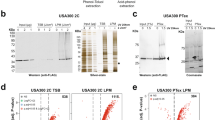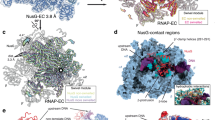Abstract
6S RNA, a highly abundant noncoding RNA, regulates transcription through interaction with RNA polymerase in Escherichia coli. Computer searches identified 6S RNAs widely among γ-proteobacteria. Biochemical approaches were required to identify more divergent 6S RNAs. Two Bacillus subtilis RNAs were found to interact with the housekeeping form of RNA polymerase, thereby establishing them as 6S RNAs. A third B. subtilis RNA was discovered with distinct RNA polymerase–binding activity. Phylogenetic comparison and analysis of mutant RNAs revealed that a conserved secondary structure containing a single-stranded central bulge within a highly double-stranded molecule was essential for 6S RNA function in vivo and in vitro. Reconstitution experiments established the marked specificity of 6S RNA interactions for σ70-RNA polymerase, as well as the ability of 6S RNA to directly inhibit transcription. These data highlight the critical importance of structural characteristics for 6S RNA activity.
This is a preview of subscription content, access via your institution
Access options
Subscribe to this journal
Receive 12 print issues and online access
$189.00 per year
only $15.75 per issue
Buy this article
- Purchase on Springer Link
- Instant access to full article PDF
Prices may be subject to local taxes which are calculated during checkout






Similar content being viewed by others
References
Brownlee, G.G. Sequence of 6S RNA of E. coli. Nat. New Biol. 22, 147–149 (1971).
Wassarman, K.M. & Storz, G. 6S RNA regulates E. coli RNA polymerase activity. Cell 101, 613–623 (2000).
Gruber, T.M. & Gross, C.A. Multiple σ subunits and the partitioning of bacterial transcription space. Annu. Rev. Microbiol. 57, 441–466 (2003).
Trotochaud, A.E. & Wassarman, K.M. 6S RNA function enhances long-term cell survival. J. Bacteriol. 186, 4978–4985 (2004).
Suzuma, S. et al. Identification and characterization of novel small RNAs in the aspS-yrvM intergenic region of the Bacillus subtilis genome. Microbiology 148, 2591–2598 (2002).
Ando, Y., Asari, S., Suzuma, S., Yamne, K. & Nakamura, K. Expression of a small RNA, BS203 RNA, from the yocI-yocJ intergenic region of Bacillus subtilis genome. FEMS Microbiol. Lett. 207, 29–33 (2002).
Zuker, M. Mfold web server for nucleic acid folding and hybridization prediction. Nucleic Acids Res. 31, 3406–3415 (2003).
Mathews, D.H., Sabina, J., Zuker, M. & Turner, D.H. Expanded sequence dependence of thermodynamic parameters improves prediction of RNA secondary structure. J. Mol. Biol. 288, 911–940 (1999).
Krakow, J.S. & von der Helm, K. Azotobacter RNA polymerase transitions and the release of σ. Cold Spring Harbor Symp. Quant. Biol. 35, 73–83 (1970).
Spassky, A., Busby, S.J.W., Danchin, A. & Buc, H. On the binding of tRNA to Escherichia coli RNA polymerase. Eur. J. Biochem. 99, 187–201 (1979).
Artsimovitch, I., Svetlov, V., Anthony, L., Burgess, R.R. & Landick, R. RNA polymerases from Bacillus subtilis and Escherichia coli differ in recognition of regulatory signals in vitro. J. Bacteriol. 182, 6027–6035 (2000).
Marchler-Bauer A. & Bryant, S.H. CD-Search: protein domain annotations on the fly. Nucl. Acids Res. 32, W327–W331 (2004).
Hengge-Aronis, R. Stationary phase gene regulation: what makes an Escherichia coli promoter σS-selective? Curr. Opin. Microbiol. 5, 591–595 (2002).
Hsu, L.M., Zagorski, J., Wang, A. & Fournier, M.J. Escherichia coli 6S RNA gene is part of a dual-function transcription unit. J. Bacteriol. 161, 1162–1170 (1985).
Griffin, B.E. & Baillie, D.L. Precursors of stable RNA accumulated in a mutant of E. coli. FEBS Lett. 34, 273–279 (1973).
Li, Z., Pandit, S. & Deutscher, M.P. 3′ exoribonucleolytic trimming is a common feature of the maturation of small, stable RNAs in Escherichia coli. Proc. Natl. Acad. Sci. USA 95, 2856–2861 (1998).
Gottesman, S. The small RNA regulators of Escherichia coli: roles and mechanisms. Annu. Rev. Microbiol. 58, 303–328 (2004).
Hilbert, D.W. & Piggot, P.J. Compartmentalization of gene expression during Bacillus subtilis spore formation. Microbiol. Mol. Biol. Rev. 68, 234–262 (2004).
Yang, Z., Zhu, Q., Luo, K. & Zhou, Q. The 7SK small nuclear RNA inhibits the CDK9/cyclin T1 kinase to control transcription. Nature 414, 317–322 (2001).
Nguyen, V.T., Kiss, T., Michels, A.A. & Bensaude, O. 7SK small nuclear RNA binds to and inhibits the activity of CDK9/cyclin T complexes. Nature 414, 322–325 (2001).
Allen, T.A., Von Kaenel, S., Goodrich, J.A. & Kugel, J.F. The SINE-encoded mouse B2 RNA represses mRNA transcription in response to heat shock. Nat. Struct. Mol. Biol. 11, 816–821 (2004).
Espinoza, C.A., Allen, T.A., Hieb, A.R., Kugel, J.F. & Goodrich, J.A. B2 RNA binds directly to RNA polymerase II to repress transcript synthesis. Nat. Struct. Mol. Biol. 11, 822–829 (2004).
Silhavy, T.J, Berman, M.L. & Enquist, L.W. Experiments With Gene Fusions (Cold Spring Harbor Laboratory Press, Cold Spring Harbor, New York, 1984).
Stibitz, S. Mutations in the bvgA gene of Bordetella pertussis that differentially affect regulation of virulence determinants. J. Bacteriol. 176, 5615–5621 (1994).
Zhang, A., Wassarman, K.M, Ortega, J., Steven, A.C. & Storz, G. The Sm-like Hfq protein increases OxyS RNA interaction with target mRNAs. Mol. Cell 9, 11–22 (2002).
Altuvia S., Weinstein-Fischer, D., Zhang, A., Postow, L. & Storz, G. A small stable RNA induced by oxidative stress: role as a pleiotropic regulator and antimutator. Cell 90, 43–53 (1997).
Altschul, S.F., Gish, W., Miller, W., Myers, E.W. & Lipman, D. A basic local alignment search tool. J. Mol. Biol. 215, 403–410 (1990).
Montzka, K.A. & Steitz, J.A. Additional low-abundance human small nuclear ribonucleoproteins: U11, U12, etc. Proc. Natl. Acad. Sci. USA 85, 8885–8889 (1988).
Sukhodolets, M.V. & Jin, D.J. RapA, a novel RNA polymerase-associated protein, is a bacterial homolog of SWI2/SNF2. J. Biol. Chem. 273, 7018–7023 (1998).
Breyer, M.J., Thompson, N.E. & Burgess, R.R. Identification of the epitope for a highly cross-reactive monoclonal antibody on the major σ factor of bacterial RNA polymerase. J. Bacteriol. 179, 1404–1408 (1997).
Anthony, L.C., Foley, K.M., Thompson, N.E. & Burgess, R.R. Expression, purification of, and monoclonal antibodies to σ factors from Escherichia coli. Methods Enzymol. 370, 181–192 (2003).
Hager, D.A., Jin, D.J. & Burgess, R.R. Use of Mono Q high-resolution ion-exchange chromotography to obtain highly pure and active Escherichia coli RNA polymerase. Biochemistry 29, 7890–7894 (1990).
Acknowledgements
We thank G. Storz for supporting experiments conducted by K.M.W. at the US National Institutes of Health (NIH). We thank S. Stibitz for providing B. pertussis cells and the Bacillus Genetic Stock Center for B. subtilis strains; R. Burgess, D. Jin and C. Price for antibodies; and L. Anthony, R. Burgess and R. Landick for RNAP preparations. We thank R. Burgess, R. Gourse, R. Landick and G. Storz for helpful discussions. This work was supported by the NIH (GM67955).
Author information
Authors and Affiliations
Corresponding author
Ethics declarations
Competing interests
The authors declare no competing financial interests.
Supplementary information
Supplementary Fig. 1
Sequence alignment. (PDF 345 kb)
Supplementary Fig. 2
Secondary structure mapping. (PDF 1802 kb)
Supplementary Table 1
Oligonucleotide sequences. (PDF 33 kb)
Rights and permissions
About this article
Cite this article
Trotochaud, A., Wassarman, K. A highly conserved 6S RNA structure is required for regulation of transcription. Nat Struct Mol Biol 12, 313–319 (2005). https://doi.org/10.1038/nsmb917
Received:
Accepted:
Published:
Issue Date:
DOI: https://doi.org/10.1038/nsmb917
This article is cited by
-
Diverse and unified mechanisms of transcription initiation in bacteria
Nature Reviews Microbiology (2021)
-
In silico prediction and expression profile analysis of small non-coding RNAs in Herbaspirillum seropedicae SmR1
BMC Genomics (2020)
-
6S RNA plays a role in recovery from nitrogen depletion in Synechocystis sp. PCC 6803
BMC Microbiology (2017)
-
Genomewide comparison and novel ncRNAs of Aquificales
BMC Genomics (2014)
-
6S RNA modulates growth and antibiotic production in Streptomyces coelicolor
Applied Microbiology and Biotechnology (2014)



